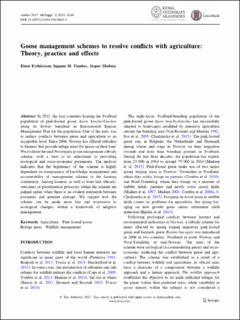| dc.description.abstract | In 2012, the four countries hosting the Svalbard population of pink-footed goose Anser brachyrhynchus along its flyway launched an International Species Management Plan for the population. One of the aims was to reduce conflicts between geese and agriculture to an acceptable level. Since 2006, Norway has offered subsidies to farmers that provide refuge areas for geese on their land. Weevaluate the mid-Norwegian goose management subsidy scheme, with a view to its adjustment to prevailing ecological and socio-economic parameters. The analysis indicates that the legitimacy of the scheme is highly dependent on transparency of knowledge management and accountability of management scheme to the farming community. Among farmers, as well as front-line officials, outcomes of prioritisation processes within the scheme are judged unfair when there is an evident mismatch between payments and genuine damage. We suggest how the scheme can be made more fair and responsive to ecological changes, within a framework of adaptive management. | en_US |
